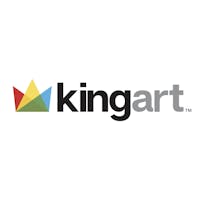
Deciding what brush to buy can be daunting. There are a variety of characteristcs, each helping to deliver paint to your surface. The right tool will make the right stroke, hold the most paint, create the right shape, work in large areas or give precise detail control. The following chart will give you some of the basics to help you make a good decision.
KINGART® brushes are handmade of synthetic fibers, work well with water base paints, and most work well with with oil based paint. They are crafted to exact standards and, when properly cared for, will give you a lifetime of painting pleasure.
Thick to thin strokes can be made by variation of pressure; use for detail work or filling large areas, depending on the brush size used and pressure applied. Also, watercolor wash effects. Commonly used brush for stroke work and borders in folk art and rosemaling.
Shaping of the round stroke with point coming from the centermost hairs makes it ideally suited for stroke work.

Continuous scrolling and straight line work, script calligraphy. Use as a liner with thinned, ink-like paint staying up on the tip. The Max Round’s fully belly acts as a reservoir, allowing continuous line work without frequent reloading. Slight pressure can be applied to vary line thickness, but belly hairs will flare out if too much presser is applied.

Very fine detail work. Examples: tiny stroke work, eyes, eyelashes, dots, signatures. Working in miniature.

Round stroke brushes are a variation on traditional round brushes. Both types have the characteristics of ferrules bunched together in a barrel shape ending in a fine point. However, round stroke brushes are far narrower with a more precise sharply pointed tip. This makes the round stroke ideal for delicate details and lines, spotting, and retouching.

Long hairs hold more liquid than a liner, but also require more control. Use to create long scrolls, straight lines or stroke work. Use pressure to change thickness.

Continuous curved or straight lines of the same thickness when uniform pressure is used, or vary pressure to create thin to thick lines. Examples: monogramming, highlighting, outlining, stroke work. Paint should be thinned to an ink-like consistency.

Mid-length liners contain longer ferrules than standard liner brushes. This allows for a greater color holding capacity when making continuous borders and outlining features, providing consistency in color retention on surfaces. This brush is great for stroke work, lettering, and fine small detailing.

Grande Round Wash brushes are a versatile option for the watercolor artist. The robust, round shape of the brush is ideal for holding plenty of color to create thick expansive strokes, while it’s pointed tip can be utilized for fine detail work. Vary the application of pressure on the brush as it glides across the canvas for transitions in opacity and hue. The grande round wash is a great alternative for the artist who is looking for a large paint brush, but prefers to work with rounds over flat artist brushes.

One-Stroke brushes have medium to long length hairs encased in a flat ferrule that allows for a great retention of color. The singular length of the hairs makes one-stroke brushes particularly proficient in hand-lettering, sign painting, and in detailed decorative artwork. This brush has a versatility working with most mediums but is exceptional with oil paint and ink.

Use on flat or chisel edge. Sharp, square shape creates crisp edges and offers precision control in tight areas. Use for: stroke work — comma, “S”, and “C;” filled circles; double load; side load to float or walk color; wash effects; blend color; block in large areas of color without ridges or paint.

Thick, heavy color; short, controlled strokes; fine precision blending.

Use for: “S,” fan, leaf, and “C” strokes; to create leaves, roses, rosebuds. Like a shader, can be double, single, and side loaded. Angled shape is suited to painting or blending in small areas and corners.

Mop brushes are highly absorbent, round, and are a much fuller version of the standard wash brush. This brush is best used to apply vast amounts of watercolor to canvas very quickly. The fullness of the Mop brush and its high paint holding capacity allows you to apply varying pressure to paper while simultaneously blending the paint creating a background full of seamless transitions of hue, and continuity of coverage with only one brush!

Rounded shape creates soft edges; blend colors as on cheeks; fill in areas; natural shape for many flower petals, leaves and bird and duck feathers.

Large, broad sweeping strokes, washes, base coating or applying finishes.

The Oval Wash is perfect for applying sweeping swaths of color to surface areas. The rounded hairs and flat ferrules work together to create soft edges upon application with no visible points and sharp edges. This form of wash brush stands out from more square washes, because it can help the artist create more ethereal and soft touches to landscape work and floral representations. Oval Washes are great for pre-wetting surface areas before paint application, as well as for absorbing excess paint.

Sky Washes are a specialty paint brush designed to retain a great amount of color. The name of the brush is reflective of the technique of creating watercolor backgrounds or the sky of a landscape due to its larger diameter, flat expanse, and rounded ferrules. Sky washes are usually 1” to 3” in width with a flat handle allowing the artist to make sweeping motions of opaque color across a surface.

Use dry or with only the tips loaded to create textured grasses, shrubbery, and trees. Also useful for smoothing brush stroke marks or softening the edges of strokes.





